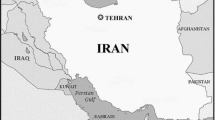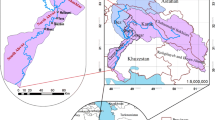Abstract
During the past decades, the command and control approaches were used to access a safe water supply policy. However, traditional methods of water management rarely consider complex interactions and outcomes of water allocations which can show their effects in feedback loops. These methods also might deteriorate the situation in long terms as they have not taken into account the outcome of such plans on the future of a watershed as a whole system. Dynamic simulation methods provide flexible tools to accomplish a holistic analysis. This ability of system dynamics method is used in this research to show the feedback of water allocation. Bookan dam is one of the constructed dams in Urmia Lake basin upstream of which four dams are being constructed. Three well known archetypes are shown in this paper that help to recognize the effect of a reservoir water supply on downstream flow. The result of dam construction and water supply priorities on Bookan dam inflow is investigated too. The difference of inflow reduction to Bookan reservoir for the best and worst policies is about 18.4 MCM which is a significant amount. Also the best preference of water demand allocation for four dams was defined as agricultural demand, domestic demand, industrial demand and environmental demand.














Similar content being viewed by others
References
Abed Elmdoust A, Kerachian R (2012) Water Resources allocation using a cooperative game with fuzzy payoffs and fuzzy coalitions. Water Resour Manag 26:3961–3976
Ahmad S, Simonovic SP (2006) An intelligent decision support system for management of floods. Water Resour Manag 20(3):391–410
Ahmad S, Simonovic SP (2004) Spatial system dynamics: new approach for simulation of water resources systems. J Comput Civ Eng 18(4):331–340
Ahmad S, Simonovic SP (2000) Dynamic modeling of flood management policies. 18th International Conference of The System Dynamics Society, Sustainability in the Third Millennium, Bergen, Norway
Albuquerque S (2001) A system model for source water assessment in the Las Vegas Valley. M. S. thesis, Department of Civil and Environmental Engineering, University of Las Vegas, Nevada, USA
Alfieri L, Perona P, Burlando P (2006) Optimal water allocation for an Alpine hydropower system under changing Scenarios. Water Resour Manag 20:761–778
Baron JS, Poff NL, Angermeier PL, Dahm CN, Gleick PH, Jackson RB, Johnston CA, Richter BD, Steinman AD (2002) Meeting ecological and societal needs for fresh water. Ecol Appl 12(5):1247–1260
Ben Alaya A, Souissi A, Tarhouni J, Ncib K (2003) Optimization of Nebhana reservoir water allocation by stochastic dynamic programming. Water Resour Manag 17:259–272. doi:10.1007/s12665-013-2801-5
Camara AS, Viegas MG, Amaro A (1986) Interfacing system dynamics and multi objective programming for regional water resources planning. Ann Reg Sci 20(3):104–113
Cartwright L, Connor J (2003) Collaborative water supply planning, a shared vision approach for the Rappanhannock Basin. In Proceedings of the 2003 UCOWR Meeting, Washington DC USA, Universities Council on Water Resources
Cohen S, Neale T (2006) Participatory integrated assessment of water management and climate change in the Okanagan Basin. British Columbia Final report, Environment Canada and University of British Columbia, Vancouver
Connor J, Cartwright L, Stephenson K (2004) Collaborative water supply planning: a shared vision approach for the Rappahannock Basin in Virginia. World Water and Environmental Resources Congress, Salt Lake City
Exter K den (2004) Integrating environmental science and management: the role of system dynamics modeling. PhD Dissertation, CRC Sustainable Tourism School of Environmental Science and Management, Southern Cross University, Queensland, Australia
Exter K den, Specht A (2003) Assisting stakeholder decision making using system dynamics group model-building. In: Proceedings of APEN National Forum, p. 43. http://www.regional.org.au/au/apen/2003/non_refereed/108denexterk.htm
Diaz-Ibarra MA (2004) A System Dynamics Model of El-Paso County Water Improvement. PhD Dissertation, Environmental Science and Engineering, University of Texas, El Paso, USA
Fernandez JM, Selma MAE (2004) The dynamics of water scarcity on irrigated Landscapes: Mazarron and Aguilas in south-eastern Spain. Syst Dyn Rev 20(2):117–137
Ganji A, Khalili D, Karamouz M, Ponnambalam K, Javan MA (2008) Fuzzy stochastic dynamic Nash game analysis of policies for managing water allocation in a reservoir system. Water Resour Manag 22:51–66. doi:10.1007/s11269-006-9143-y
Gastelum Perez JR (2006) Analysis of water resources alternatives to improve water allocation on the Conchos Basin during drought situation. PhD Dissertation, University of Arizona, USA
Gleick PH (2000) The changing water paradigm- a look at twenty first century water resources development. Water Int 25(2):127–138
Guo HC, Liu L, Huang GH, Fuller GA, Zou R, Yin YY (2001) A system dynamics approach for regional environmental planning and management: a study for the Lake Erhai Basin. J Environ Manag 61(1):93–111
Hassanzadeh E, Zarghami M, Hassanzadeh Y (2012) Determining the main factors in declining the Urmia Lake level by using system dynamics modeling. Water Resour Manag 26:129–145
Higgins A, Archer A, Hajkowicz S (2008) A stochastic non-linear programming model for a multi-period water resource allocation with multiple objectives. Water Resour Manag 22:1445–1460
Homayounfar M, Ganji A, Martinez CJ (2011) A novel solution for stochastic dynamic game of water allocation from a reservoir using collocation method. Water Resour Manag 25:3427–3444
Jackson RB, Carpenter SR, Dahm CN, McKnight DM, Naiman RJ, Postel SL, Running SW (2001) Water in a changing world. Ecol Appl 11(4):1027–1045, http://esa.sdsc.edu/
Jacobson J, Sehlke G (2005) System dynamics modeling of trans boundary systems: the Bear River basin model. Ground Water 43(5):722–730
Karimi A, Ardakanian R (2010) Development of a dynamic long-term water allocation model for agriculture and industry water demands. Water Resour Manag 24:1717–1746. doi:10.1007/s11269-009-9521-3
Leal Neto AC, Legey LFL, Gonzalez-Araya MC, Jablonski S (2006) A system dynamics model for the environmental management of the Sepetiba Bay watershed, Brazil. Environ Manag 38(5):879–888
Li YP, Huang GH (2008) Interval-parameter two-stage stochastic nonlinear programming for water resources management under uncertainty. Water Resour Manag 22:681–698
Li YP, Huang GH, Chen X (2009) Multistage scenario-based interval-stochastic programming for planning water resources allocation. Stoch Environ Res Risk Assess 23:781–792. doi:10.1007/s00477-008-0258-y
Louati MH, Benabdallah S, Lebdi F, Milutin D (2011) Application of a genetic algorithm for the optimization of a complex reservoir system in Tunisia. Water Resour Manag 25:2387–2404. doi:10.1007/s11269-011-9814-1
Mirchi A, Madani K, Watkins D, Ahmad S (2012) Synthesis of system dynamics tools for holistic conceptualization of water resources problems. Water Resour Manag 26:2421–2442
Nikoo MR, Karimi A, Kerachian R (2013) Optimal long-term operation of reservoir-river systems under hydrologic uncertainties: application of interval programming. Water Resour Manag 27:3865–3883
Nikoo MR, Kerachian R, Karimi A, Azadnia AA, Jafarzadegan K (2014) Optimal water and waste load allocation in reservoir–river systems: a case study. Environ Earth Sci 71:4127–4142
Passell HD, Tidwell VC, Conrad SH, Thomas RP, Roach J (2003) Cooperative water resources modeling in the Middle Rio Grande Basin. Technical Report
Peterson TR, Kenimer A, Grant WE (2004) Mediated modeling, a system dynamics approach to environmental consensus building. Chapter: using mediated modeling to facilitate collaborative learning among resident of the San Antonio Watershed. Island Press, Texas, pp 136–163
Rahbord Danesh Pouya Institue (2009) Tehran, Iran
Saysel AK (2004) System dynamics model for integrated environmental assessment of large scale surface irrigation. Technical Report 2. The System Dynamics Group, Department of Information Science, University of Bergen, Norway
Simonovic SP (2009) Managing water resources: methods and tools for a systems approach. UNESCO, Paris and Earthscan, James & James, London
Simonovic SP, Rajasekaram V (2004) Integrated analyses of Canada’s water Resources: a system dynamics approach. Can Water Resour J 29(4):223–250
Simonovic SP (2002a) Global water dynamics: issues for the 21st century. Water Sci Technol 45(8):53–64
Simonovic SP (2002b) World water dynamics: global modeling of water resources. J Environ Manag 66:249–267
Simonovic SP, Fahmy H (1999) A new modeling approach for water resources policy analysis. Water Resour Res 35:295–304
Stave KA (2003) A system dynamics model to facilitate public understanding of water management options in Las Vegas Nevada. J Environ Manag 67(4):303–313
Sterman JD (2000) Business dynamics: systems thinking and modeling for a complex world. McGraw-Hill, Boston
Tennant DL (1976) In stream flow regimens for fish, wildlife, recreation and related environmental resources. Fisheries 1:6–10
Tidwell VC, Passell HD, Conrad SH, Thomas RP (2004) System dynamics modeling for community-based water planning: application to the Middle Rio Grande. Aquat Sci 66:35–372
Van den Belt M (2004) Mediated modeling- a system dynamics approach to environmental consensus building. Island Press, Washington
Ventana Systems (2010) User’s guide version 5, Ventana Systems, Inc. http://www.vensim.com
Winz I, Brierley G (2007) The use of system dynamics simulation in integrated water resources management. Proceedings of the 25th International Conference of the System Dynamics Society and 50th Anniversary Celebration, Boston
Xu HG (2001) Exploring effective policies for underground water management in artificial oasis: a system dynamics analysis of a case study of Yaoba Oasis. J Environ Sci (China) 13(4):476–480
Author information
Authors and Affiliations
Corresponding author
Rights and permissions
About this article
Cite this article
Ghashghaie, M., Marofi, S. & Marofi, H. Using System Dynamics Method to Determine the Effect of Water Demand Priorities on Downstream Flow. Water Resour Manage 28, 5055–5072 (2014). https://doi.org/10.1007/s11269-014-0791-z
Received:
Accepted:
Published:
Issue Date:
DOI: https://doi.org/10.1007/s11269-014-0791-z




